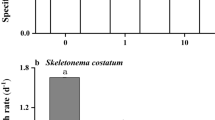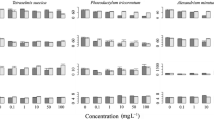Abstract
The influence of hormonelike xenobiotics (HLXs), i.e., octyland nonylphenols, on microalgae has been investigated. Studies have shown that the effect of HLXs on the life and activity of the hydrobionts under consideration depends on their chemical structure, concentration, and algae taxonomic group. Nonylphenols (NPs) have shown greater toxicity than that of octylphenols (OPs) for all algae studied: the concentrations of NPs (EC 50) that induce 50% inhibition of the growth of microalgae are 1.5–3.3 times lower than EC 50 for OP (depending on the culture). It has been established that blue-green algae are more sensitive to alkylphenols, while green algae are less sensitive to them. The 20–30% stimulation of the growth of cyanobacteria of genus Microcystis was revealed in the presence of low NP and OP concentrations. Under stress conditions induced by alkylphenols, changes in the formation of photosynthetic pigments are observed and the stimulation of the synthesis of algotoxins and odorants (geosmin and 2-methylisoborneol) is possible.
Similar content being viewed by others
References
Butakova, E.A., Specific features of odor-causing compounds (geosmin and 2-methylisoborneol) as secondary metabolites of cyanobacteria, Russ. J. Plant Physiol., 2013, vol. 60, no. 4, pp. 507–510.
Gusev, E.E., Odor-causing compounds of biological origin in natural waters and methods for their removal in water treatment, Extended Abstract of Cand. Sci. (Techn.) Dissertation, Moscow, 2007.
Baptista, M.S., Stoichev, T., Basto, M.C.P., et al., Fate and effects of octylphenol in a Microcystis aeruginosa culture medium, Aquat. Toxicol., 2009, vol. 92, no. 2, pp. 59–64.
Brooke, D., Johnson, I., Mitchell, R., and Watts, C., Environmental Risk Evaluation Report: 4-tert-Octylphenol, Bristol: Environ. Agency, 2005.
David, A., Fenet, H., and Gomez, E., Alkylphenols in marine environments: distribution monitoring strategies and detection considerations, Mar. Pollut. Bull., 2009, vol. 58, pp. 953–960.
EU-RAR. European Union Risk Assessment on 4Nonylphenol (Branched) and Nonylphenol. Final Report. European Union Risk Assessment Report 10. European Chemicals Bureau. Luxemburg: Office for Official Publ. Eur. Comm., 2002.
Gao, Q.T. and Tam, N.F.Y., Growth, photosynthesis and antioxidant responses of two microalgal species, Chlorella vulgaris and Selenastrum capricornutum, to nonylphenol stress, Chemosphere, 2011, vol. 82, no. 3, pp. 346–354.
Jeffrey, S.W. and Humprhray, G.E., New spectrophotometric equations for determining chlorophylls a, b, c1 and c2 in higher plants, algae and natural phytoplankton, Biochem. Physiol. Pflanzen, 1975, vol. 167, no. 2, pp. 191–194.
Jonsson, B., Risk assessment on butylphenol, octylphenol and nonylphenol, and estimated human exposure of alkylphenols from Swedish fish, Ekotoxikologiska Avdelningen, Uppsala: Uppsala Univ, 2006, vol. 109.
Jüttner, F. and Watson, S.B., Minireview: biochemical and ecological control of geosmin and 2-methylisoborneol in source waters, Appl. Environ. Microbiol., 2007, vol. 73, p. 4395.
Kannan, K., Kober, J.L., Khim, J.S., et al., Polychlorinated biphenils, polycyclic aromatic hydrocarbons and alkylphenols in sediments from the Odra River and its tributaries, Poland, Toxicol. Environ. Chem., 2003, vol. 85, nos. 4–6, pp. 51–60.
Knez, J., Endocrine-disrupting chemicals and male reproductive health, Reproduct. BioMed. Online, 2013, no. 26, pp. 440–448.
Lawton, L.A., Edwards, C., and Codd, G.A., Extraction and high-performance liquid chromatographic method for the determination of microcystins in raw and treated waters, Analyst, 1994, no. 119, pp. 1525–1530.
Lilja, K., Norström, K., Remberger, M., et al., Screening of selected hazardous substances in the eastern Baltic marine environment. Report B1874. IVL. Stockholm: Swed. Environ. Res. Inst., 2009.
Parsons, T.R. and Strickland, J.D.H., Discussion of spectrophotometric determination of marine-plant pigments with revised equations for ascertaining chlorophylls and carotenoids, J. Mar. Res., 1963, no. 21, pp. 155–163.
Perron, M.-C. and Juneau, P., Effect of endocrine disrupters on photosystem II energy fluxes of green algae and cyanobacteria, Environ. Res., 2011, vol. 111, pp. 520–529.
Polyak, Yu.M., Zaytseva, T.B., Petrova, V.N., and Medvedeva, N.G., Development of mass cyanobacteria species under heavy metals pollution, Hydrobiol. J., 2011, vol. 47, no. 3, pp. 75–90.
Porter, A.J. and Hayden, N.J., Nonylphenol in the Environment: A Critical Review, Burlington: Univ. Vermont, 2003.
Qian, H., Pan, X., Shi, S., et al., Effect of nonylphenol on response of physiology and photosynthesis-related gene transcription of Chlorella vulgaris, Environ. Monit. Assess., 2011, no. 182, pp. 61–69.
Servos, M.R., Review of the aquatic toxicity, estrogenic responses and bioaccumulation of alkylphenols and alkylphenols polyethoxylates, Water Qual. Res. J. Can., 1999, no. 34, pp. 123–177.
Siegelman, H.W. and Kycia, J.H., Algal biliproteins, in Handbook of Phycological Methods, Physiological and Biochemical Methods, Cambridge: Cambridge Univ. Press, 1978.
Soares, A., Guieysse, B., Jefferson, B., et al., Nonylphenol in the environment: a critical review on occurrence, fate, toxicity and treatment in wastewaters, Environ. Int., 2008, vol. 34, pp. 1033–1049.
Stanier, R.Y., Kunisawa, R., Mandel, M., and CohenBazire, G., Purification and properties of unicellular blue-green algae (order Chroococcales), Bacteriol. Rev., 1971, no. 35, pp. 171–205.
Vazquez-Duhalt, R., Marquez-Rocha, F., Ponce, E., et al., Nonylphenol, an integrated vision of a pollutant. Scientific review, Appl. Ecol. Environ. Res., 2005, vol. 4, pp. 1–25.
Wang, J., Xie, P., and Guo, N., Effects of nonylphenol on the growth and microcystin production of microcystis strains, Environ. Res, 2007, vol. 103, no. 1, pp. 70–78.
Youngs, L., Bevan, R., and Ashdown, L., Endocrine Disrupting Chemicals: Overview of Recent Published Literature, Bedfordshire: Inst. Environ. Health, 2012.
Author information
Authors and Affiliations
Corresponding author
Rights and permissions
About this article
Cite this article
Zaytseva, T.B., Medvedeva, N.G. & Mamontova, V.N. Peculiarities of the effect of octyl- and nonylphenols on the growth and development of microalgae. Inland Water Biol 8, 406–413 (2015). https://doi.org/10.1134/S1995082915040161
Received:
Published:
Issue Date:
DOI: https://doi.org/10.1134/S1995082915040161




